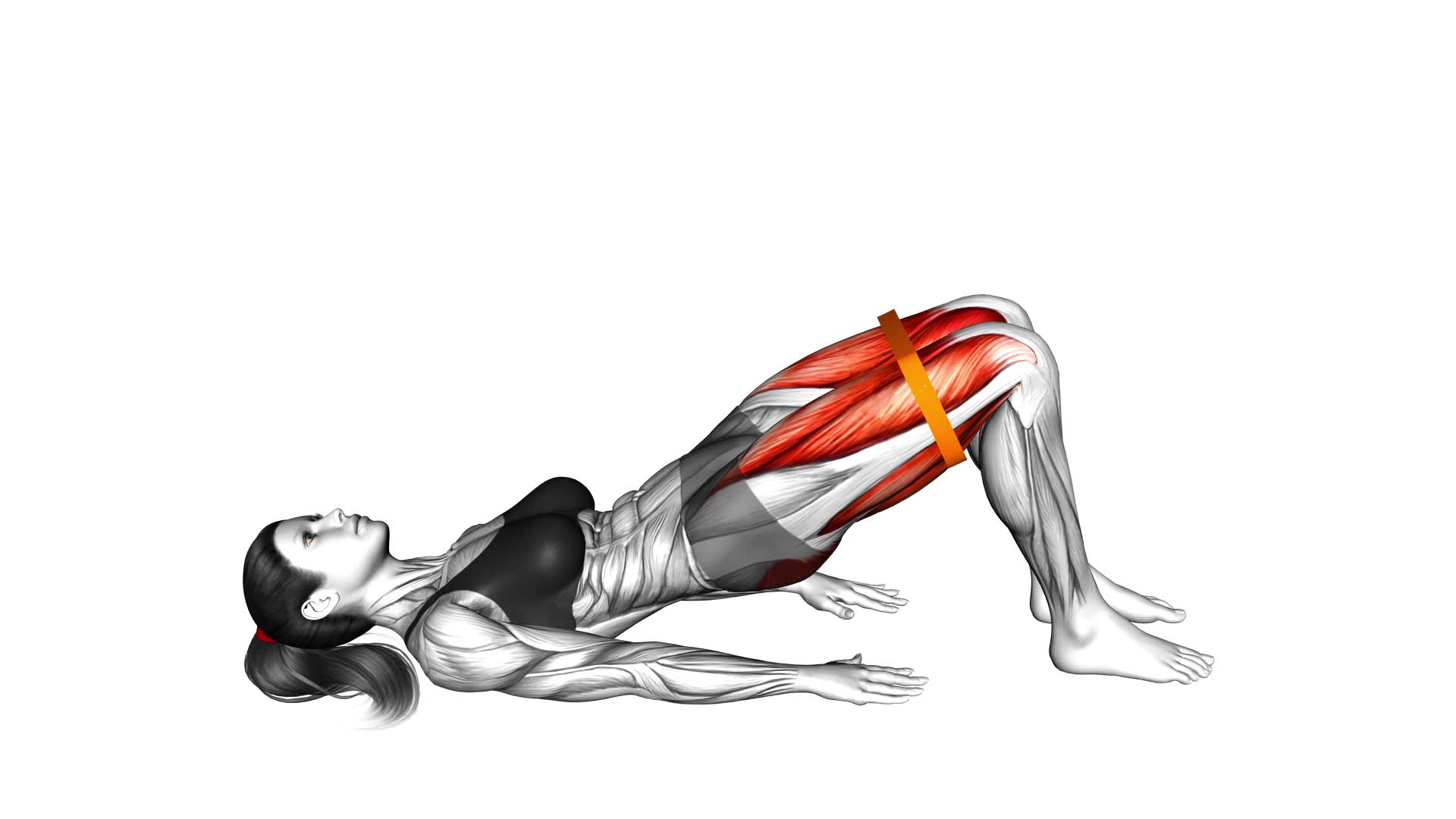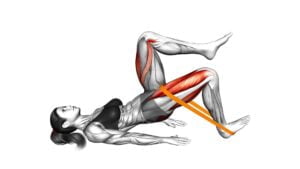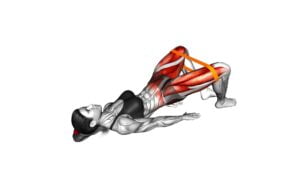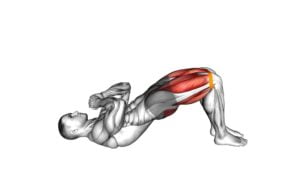Resistance Band Glute Bridge (female) – Video Exercise Guide & Tips

Looking to strengthen your glutes? The resistance band glute bridge is the perfect exercise for you. In this video exercise guide, we'll show you how to properly perform the glute bridge using a resistance band.
Watch This Exercise Video
You'll learn about the benefits, proper form and technique, and how to choose the right resistance band for your fitness level. Plus, we'll share variations, common mistakes to avoid, and tips for maximizing your glute bridge workout.
Get ready to feel the burn!
Key Takeaways
- The resistance band glute bridge improves posture, strengthens the core, and targets imbalances in the lower body.
- Proper form and technique, including engaging the core and avoiding arching the back, are crucial for injury prevention.
- Choosing the right resistance band that challenges muscles without compromising form is important.
- Variations and progressions, such as single-leg glute bridge and banded glute bridge with abduction, can target different muscle fibers and increase difficulty as strength improves.
Benefits of the Resistance Band Glute Bridge
To experience the benefits of the Resistance Band Glute Bridge, incorporate this compound exercise into your fitness routine. This exercise is highly effective in improving posture and strengthening the core. By targeting the glute muscles, it helps to correct imbalances and weaknesses in the lower body, which can often lead to poor posture.
As the glute muscles become stronger, they provide better support for the spine, allowing you to maintain a more upright and aligned posture throughout the day. Additionally, the Resistance Band Glute Bridge engages the core muscles, including the abdominals and lower back, to stabilize the body during the movement. This not only strengthens the core, but also helps to improve overall balance and stability.
Proper Form and Technique
To perform the Resistance Band Glute Bridge with proper form and technique, follow these steps.
- Start by lying on your back with your knees bent and feet flat on the ground.
- Place a resistance band just above your knees and keep your arms relaxed by your sides.
- Engage your core muscles and squeeze your glutes as you lift your hips off the ground, creating a straight line from your knees to your shoulders.
- Make sure to maintain a neutral spine throughout the exercise and avoid arching your back.
- As you reach the top of the movement, pause for a second and then slowly lower your hips back down to the starting position.
- Repeat for the desired number of repetitions.
There are a few common misconceptions when it comes to the Resistance Band Glute Bridge.
One is the belief that the higher you lift your hips, the better the exercise. However, it's important to focus on quality rather than quantity. By maintaining proper form and technique, you'll activate your glutes effectively and minimize the risk of injury.
Another misconception is that you need to use a heavy resistance band to see results. The key is to choose a resistance band that provides enough tension to challenge your muscles without compromising your form.
Proper form and technique are crucial for injury prevention during the Resistance Band Glute Bridge.
By keeping your core engaged and your glutes squeezed, you'll protect your lower back and avoid straining your hip flexors. It's also important to avoid excessive arching of the back, as this can lead to discomfort and potential injury.
Remember to listen to your body and start with a resistance band that suits your current strength level. As you progress, you can gradually increase the resistance to continue challenging your muscles and achieving optimal results.
How to Choose the Right Resistance Band
When choosing the right resistance band for the Resistance Band Glute Bridge, consider the level of tension that will challenge your muscles without compromising your form. Resistance band exercises offer a versatile and effective way to target and strengthen your glutes.
There are different types of resistance bands available, each offering varying levels of resistance. The three main types are loop bands, tube bands, and figure-eight bands. Loop bands are perfect for exercises that require a continuous loop, such as the Glute Bridge. Tube bands are ideal for exercises that involve pulling and pushing movements, while figure-eight bands are great for targeting specific muscle groups.
To choose the right resistance band, start with a lighter band and gradually increase the resistance as you get stronger. It's important to choose a band that allows you to complete the exercise with proper form and without excessive strain. As you progress, you can experiment with different bands to continue challenging your muscles.
Now that you know how to choose the right resistance band, let's move on to exploring variations and progressions of the Resistance Band Glute Bridge.
Variations and Progressions
Continue exploring different ways to challenge and strengthen your glutes with variations and progressions of the Resistance Band Glute Bridge exercise. By incorporating these variations and progressions into your workout routine, you can target different muscle fibers and enhance the effectiveness of your glute training.
Here are some options to consider:
- Single-Leg Glute Bridge: Lift one leg off the ground while performing the glute bridge. This variation increases the demand on the working glute and promotes balance and stability.
- Banded Glute Bridge with Abduction: Place a resistance band around your knees and perform the glute bridge while simultaneously pushing your knees outward. This variation activates the glutes and the outer thigh muscles, helping to strengthen the entire hip area.
- Banded Glute Bridge with Marching: Similar to the standard glute bridge, but with the addition of marching by alternating lifting one knee at a time. This progression challenges your core stability and further engages the glutes.
Incorporating these variations and progressions into your glute bridge exercise routine can help you continue to challenge your glutes and make progress in your training. Remember to focus on proper form and gradually increase the difficulty as you become stronger.
Common Mistakes to Avoid
Avoid falling into common mistakes when performing the Resistance Band Glute Bridge exercise. By understanding and avoiding these mistakes, you can ensure that you're maximizing the benefits of this exercise while minimizing the risk of injuries.
One common mistake to avoid is failing to maintain proper form throughout the exercise. It's important to keep your core engaged and your back flat against the ground. This won't only help in improving stability and balance, but also prevent any unnecessary strain on your lower back.
Another mistake to avoid is using too much tension in the resistance band. While it's important to challenge yourself, using too much tension can lead to improper form and increase the risk of injuries. Start with a lighter resistance band and gradually increase the tension as you become more comfortable with the exercise.
Lastly, avoid rushing through the exercise. Take your time to perform each rep with control and precision. This won't only help in improving stability and balance, but also maximize the activation of your glute muscles. Remember, quality over quantity is key when it comes to resistance band glute bridge exercises.
Tips for Maximizing Your Glute Bridge Workout
To maximize your glute bridge workout, it's essential to focus on proper form techniques. Make sure to maintain a neutral spine and engage your glutes throughout the entire movement.
Additionally, increasing the resistance level by using heavier bands or weights can help challenge your muscles and promote growth.
Proper Form Techniques
To maximize your glute bridge workout, use proper form techniques. Here are some tips to help you get the most out of this exercise:
- Engage your core: Before lifting your hips off the ground, make sure to activate your abdominal muscles. This will help stabilize your body and prevent any strain on your lower back.
- Squeeze your glutes: As you lift your hips, focus on squeezing your glutes at the top of the movement. This will ensure that you're effectively targeting your glute muscles and maximizing the benefits of the exercise.
- Maintain a neutral spine: Avoid arching your back or tucking your pelvis too much. Keep your spine in a neutral position throughout the exercise to protect your lower back and maintain proper alignment.
By following these form techniques, you can optimize your glute bridge workout and achieve the desired results.
Don't fall for common misconceptions and make sure to perform the exercise correctly for maximum effectiveness.
Increasing Resistance Level
Are you looking to take your glute bridge workout to the next level by increasing the resistance level?
Adjusting the resistance of your glute bridge exercise can help in challenging your muscles and maximizing your workout.
One way to increase the resistance is by using a stronger resistance band. This can be achieved by choosing a band with higher tension or by doubling up on the bands for added resistance.
Another option is to use ankle weights or hold a dumbbell on your hips while performing the glute bridge. These methods will provide more resistance and make your muscles work harder, leading to increased strength and muscle growth.
By adjusting the resistance level, you can continue to challenge your muscles and progress in your glute bridge workout routine.
Now, let's explore some variations to further intensify the exercise.
Incorporating Variations for Intensity
To further intensify your glute bridge workout and maximize the effectiveness of your routine, incorporate variations that increase the intensity and challenge your muscles.
Here are some advanced modifications you can try:
- Single-Leg Glute Bridge: Lift one leg off the ground while performing the glute bridge to increase the difficulty and engage your glutes even more.
- Banded Glute Bridge: Place a resistance band just above your knees and push against it as you lift your hips, adding extra resistance and targeting your glutes and outer thighs.
- Weighted Glute Bridge: Hold a dumbbell or a barbell across your hips as you perform the exercise. The added weight will increase the challenge and help build strength in your glutes.
Remember to start with a weight or variation that challenges you but still allows for proper form. As you get stronger, gradually increase the difficulty to continue making progress.
Frequently Asked Questions
How Many Repetitions Should I Do for the Resistance Band Glute Bridge Exercise?
To get the most out of the resistance band glute bridge exercise, it's important to know how many repetitions to do. The number of repetitions you should do depends on your fitness level and goals. Generally, it's recommended to start with 8-12 repetitions and gradually increase as you get stronger.
Doing this exercise regularly can help strengthen and tone your glutes, improve hip stability, and enhance overall lower body strength. There are also variations of this exercise you can try to add variety to your workout routine.
Can Men Also Benefit From Doing the Resistance Band Glute Bridge?
Yes, men can definitely benefit from doing the resistance band glute bridge exercise. It helps to strengthen the glutes, which is important for both men and women.
The resistance band adds an extra challenge and can help to target the muscles even more effectively. Plus, there are variations available for different fitness levels, so you can adjust the intensity based on your own needs and goals.
Are There Any Specific Warm-Up Exercises Recommended Before Performing the Resistance Band Glute Bridge?
Before performing the resistance band glute bridge, it's important to do specific warm-up exercises. These exercises help activate the muscles and prepare them for the movement.
Additionally, men can also benefit from doing the resistance band glute bridge. It helps strengthen the glutes and improve overall lower body strength.
Incorporating this exercise into your routine can lead to improved athletic performance and reduced risk of injuries.
Can I Do the Resistance Band Glute Bridge Exercise if I Have Lower Back Pain?
If you have lower back pain, it's important to be cautious when doing the resistance band glute bridge. While it can be an effective exercise, it may put strain on your lower back.
Instead, consider alternative exercises that target your glutes without causing discomfort. You can try modified versions of the glute bridge, such as the glute bridge with a stability ball or the single-leg glute bridge.
These modifications can help reduce the stress on your lower back while still working your glutes effectively.
Is It Necessary to Use a Resistance Band for the Glute Bridge Exercise, or Can I Use Other Equipment?
To answer your question, using a resistance band for the glute bridge exercise isn't necessary. You have the option to use alternative equipment such as dumbbells or a barbell.
The resistance band provides additional resistance and targets the glutes, but other equipment can still effectively work the same muscle groups.
It's important to choose equipment that suits your preferences and goals. Different equipment can offer various benefits for different muscle groups.
Conclusion
In conclusion, the resistance band glute bridge is a highly effective exercise for targeting and strengthening the glute muscles.
By using the proper form and technique, choosing the right resistance band, and incorporating variations and progressions, you can maximize the benefits of this workout.
Avoiding common mistakes and following the provided tips will help you achieve optimal results.
Incorporate the resistance band glute bridge into your fitness routine for stronger and toned glutes.

Author
Years ago, the spark of my life’s passion ignited in my mind the moment I stepped into the local gym for the first time. The inaugural bead of perspiration, the initial endeavor, the very first surge of endorphins, and a sense of pride that washed over me post-workout marked the beginning of my deep-seated interest in strength sports, fitness, and sports nutrition. This very curiosity blossomed rapidly into a profound fascination, propelling me to earn a Master’s degree in Physical Education from the Academy of Physical Education in Krakow, followed by a Sports Manager diploma from the Jagiellonian University. My journey of growth led me to gain more specialized qualifications, such as being a certified personal trainer with a focus on sports dietetics, a lifeguard, and an instructor for wellness and corrective gymnastics. Theoretical knowledge paired seamlessly with practical experience, reinforcing my belief that the transformation of individuals under my guidance was also a reflection of my personal growth. This belief holds true even today. Each day, I strive to push the boundaries and explore new realms. These realms gently elevate me to greater heights. The unique combination of passion for my field and the continuous quest for growth fuels my drive to break new ground.







